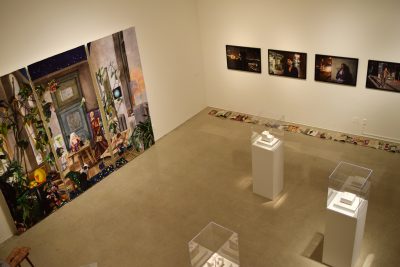 Claremont, Calif. (January 26, 2017)—The Pitzer College Faculty Art Show examines the legacy of the College’s Art Field Group and the art faculty’s ongoing dedication to progressive ideas surrounding art, the natural and built environment, and the impact of human actions—and interactions. Works by Pitzer’s current art professors—Tim Berg, Sarah Gilbert, Tarrah Krajnak and Jessica McCoy—share a gallery with artwork and artifacts from professors who shaped the study and practice of art at Pitzer. The exhibition is curated by Professor of Art Bill Anthes and Pitzer College Art Galleries Director Ciara Ennis. The Faculty Art Show opens today at the Nichols Gallery, Pitzer College.
Claremont, Calif. (January 26, 2017)—The Pitzer College Faculty Art Show examines the legacy of the College’s Art Field Group and the art faculty’s ongoing dedication to progressive ideas surrounding art, the natural and built environment, and the impact of human actions—and interactions. Works by Pitzer’s current art professors—Tim Berg, Sarah Gilbert, Tarrah Krajnak and Jessica McCoy—share a gallery with artwork and artifacts from professors who shaped the study and practice of art at Pitzer. The exhibition is curated by Professor of Art Bill Anthes and Pitzer College Art Galleries Director Ciara Ennis. The Faculty Art Show opens today at the Nichols Gallery, Pitzer College.
“The show explores the relationship between art and environmentalism, which has always been a focus for faculty in the Art Field Group, both historically and contemporaneously,” said Ennis.
In Pitzer’s Nichols Gallery, works by current art faculty are downstairs while pieces by former Pitzer professors Carl Hertel, David Furman, Kathryn Miller and Michael Woodcock are displayed on the mezzanine that overlooks the gallery below. Ennis says that the “choreography of the space” reflects the historical framing of the show.
“In terms of display, you’re looking down from the past onto the present,” Ennis said.
Brown Pelican, a print by Pitzer alumnus and Professor of Environmental Analysis Paul Faulstich ’79, P’15, is exhibited on the stairway between the two levels, creating a link between past and present. Faulstich majored in studio art and environmental studies as an undergraduate at Pitzer and studied with Hertel, who came to the College in 1966 as Pitzer’s first professor of art and environmental design. Today, Faulstich continues to integrate his environmental studies with artwork, which is shown on the upper mezzanine along with works from the professors who influenced him as a student.
All the works on display, along with evoking environmental awareness and concerns, are “political to some degree,” Ennis said.
Associate Professor of Art Tim Berg and artist Rebekah Myers’ works “create prompts for the audience to consider a world driven by our insatiable desire and our place within that world,” Berg and Myers say in their artist statement.
Sculptor Sarah Gilbert, assistant professor of art, synthesizes traditional craft techniques with emerging technologies in pieces that explore “changing definitions of the human and post-human.”
In Forking Paths, Assistant Professor of Art Tarrah Krajnak examines “the particular sites of intersection between my own life and the turbulent period in the history of Lima” through images, archival materials and found photographs from Peru in 1979.
Associate Professor of Art Jessica McCoy’s paintings and collages often focus on private spaces and the landscapes of home life. In the watercolor Room, she “probes a personal experience of motherhood, exploring themes of possession, covetousness and shame,” she says in her artist statement.
The Pitzer College Art Galleries worked in collaboration with the Pitzer College Archives to gather former art professors’ works and artifacts from some of their creative, collaborative courses. Archivist Stacy Elliott notes that Pitzer “has a tradition of approaching critical human questions in new ways.” At Pitzer College, art has never been taught solely in classrooms or studios; here, arts education breaks out of four walls and rewrites course catalogs. This history is captured on the upper level of the gallery, which holds ephemera from some of the inventive, adventurous independent studies and colloquiums created by art faculty and their colleagues and often inspired by their students.
The exhibition’s curators say viewers will see a through-line between this history and recent art courses at Pitzer, which include The Desert as a Place; Math, Art, and the Environment; Object Ecologies; EcoPoetics and Photography; Mural Painting; and Art and Animals.
For Pitzer faculty and students, art has been an “interdisciplinary laboratory in which to grapple with issues of environmental sustainability, intercultural understanding, and to engage diverse communities,” said co-curator Anthes. “It’s important that we make known that Pitzer’s art faculty have always been part of what makes Pitzer unique as an institution.”